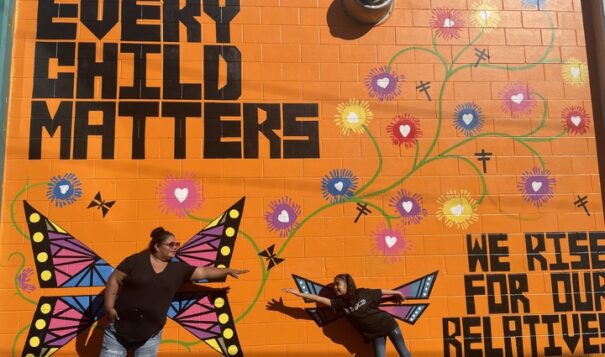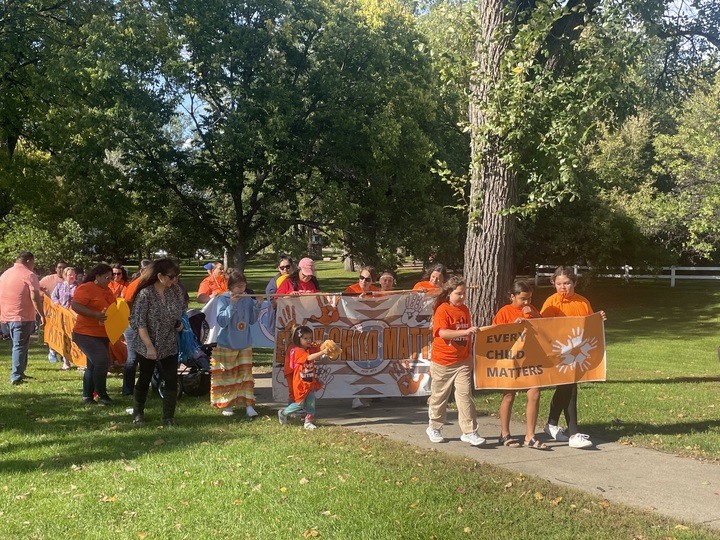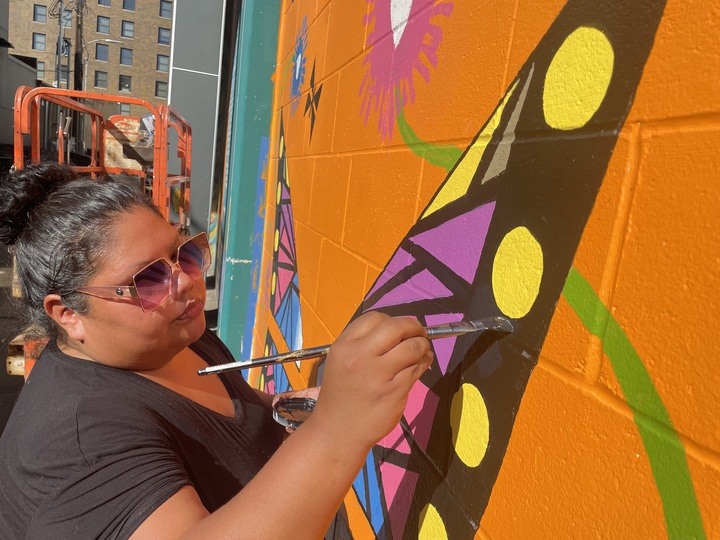News Based on facts, either observed and verified directly by the reporter, or reported and verified from knowledgeable sources.
Leaders, community members gather to support bill to find remains of missing boarding school children
 Melanie Moniz and her 9-year-old daughter Angelina Grace helped paint dragonflies and butterflies on the mural, representing messengers and protectors on Sept. 30. Photo credit/Adrianna Adame
Melanie Moniz and her 9-year-old daughter Angelina Grace helped paint dragonflies and butterflies on the mural, representing messengers and protectors on Sept. 30. Photo credit/Adrianna Adame
Memorial walk brings together survivors, families to heal
Fifty years after a devastating residential school experience marked Canadian Indigenous author Phyllis Webstad for life, the movement she founded has made its way to the streets of Bismarck.
Now in its third year, grassroots collective Orange Shirt Day North Dakota held a memorial walk on Sept. 30 to honor Indian boarding school survivors and remember the children who never made it home.
About 100 people peacefully walked in a procession for six blocks from Custer Park to Art Alley for “Walking for Our Relatives.” Once everyone arrived at the destination, an interactive mural was unveiled, honoring the children and survivors of the boarding schools. The flowers on the mural represent the 18 boarding schools that were in North Dakota.
Different generations helped with each handprint on the mural throughout its five-day creation. Melanie Moniz, one of the organizers, said dragonflies and the butterflies in many tribal nations represent messengers and protectors.
The holiday, also known as the National Day of Truth and Reconciliation in Canada, aims to raise awareness while providing a space for healing, enlightenment and empowerment for a better future. Moniz said the first step to begin mending from this historical trauma is to acknowledge what occurred in these institutions.
“They were like prisons, and they targeted the most sacred, innocent, vulnerable members of our society. Our children.”
Agnes Yellow Bird, Memorial Walk Organizer
“These schools were tools of colonization, assimilation and genocide, resulting in the loss of our land, languages, cultures, traditional foods and the permanent separation of children from their families,” said Moniz.
The Indian boarding schools sought to “kill the Indian, save the man” through forced cultural assimilation. Indigenous children were taken away from their families and stripped of their identities once they arrived at these institutions. Students’ hair was cut, they were banned from speaking their Native language and made to become “Americanized.”
Often at these schools, children died from illness, malnutrition or other unknown causes. Others endured physical and sexual abuse, as well as neglect. Agnes Yellow Bear, one of the memorial walk organizers, said it’s important to recognize the Indian boarding schools for what they were.
“They call them schools, but they weren’t schools. We didn’t learn anything from those institutions,” said Yellow Bear. “They were like prisons, and they targeted the most sacred, innocent, vulnerable members of our society. Our children.”
These church- and government-funded schools stole hundreds of thousands of Native children between 1869 to 1969. More than 20,000 children attended the boarding schools by 1920, according to the National Native American Boarding School Healing Coalition.

Webstad, the founder of the Orange Shirt Society, initiated the movement after her experience attending the Mission School for a year in British Columbia. When she was 6 years old, her grandmother put together the little money they had to buy her a shirt to wear for the first day of school. Educators at the institution took away Webstad’s clothes once she arrived, including her orange shirt.
After that day in 1973, the color orange reminded Webstad of how the incident – and the residential school in general – made her feel that her feelings didn’t matter and that she was worth nothing. “All of us little children were crying, and no one cared,” Webstad wrote on the OSS website.
Forty years later, in 2013, Webstad formed her non-profit, the Orange Shirt Society, and held the first Orange Shirt Day in Williams Lake, B.C. The movement has since become widely recognized in both the United States and Canada every year.
Orange Shirt Day North Dakota recognized survivors of the boarding schools throughout the event by giving them the opportunity to speak about their experiences. Those who didn’t feel comfortable opening up about their past were given gifts privately by the collective so that they’d still be honored. Yellow Bear said intimate moments like these create change for Indigenous communities as a whole.
“We want to know the truth of what happened to our kids,” said Seminole. “No school should have a cemetery.”
Prairie Rose Seminole, Indigenous Fellow
“You know the beauty of seeing one relative have courage, have strength and bravery to share their story – it impacts everyone. It’s really brought about a whole movement in Canada,” Yellow Bear said.
American Indian communities across the United States quickly began honoring Orange Shirt Day after its introduction in Canada by holding their own marches. The movement is also gaining support in Congress.
Orange Shirt Day North Dakota also welcomed representatives and advocates to speak about Senate Bill 1723, a demand for policy change.
The bill, known as the Truth and Healing Commission on Indian Boarding School Policies Act, was introduced in Congress by Sen. Elizabeth Warren, D-Mass., to the Committee of Indian Affairs in May.

If passed, the bill will allocate resources to determine the location of the children, document ongoing impacts from boarding schools, locate church and government records and hold culturally appropriate public hearings to collect testimony from survivors or descendants. The commission will also file a final report with recommendations on how to promote healing among residential school victims and their descendants, according to The National Native American Boarding School Healing Coalition.
Prairie Rose Seminole, an Indigenous Fellow at the National Parks Conservation Association who spoke at the event, went to Wahpeton Indian School in the early 1990s. She honored the grave of the single unknown student there, often thinking about what led to the child’s death. “We want to know the truth of what happened to our kids,” said Seminole. “No school should have a cemetery.”
There were 14 federal Indian boarding schools in North Dakota, according to the Bureau of Indian Affairs. Orange Shirt Day North Dakota said there were at least 18 institutions in the state, including private and state schools. Altogether more than 360 federally run schools existed across the United States.
Agnes Yellow Bird, Memorial Walk Organizer
“You know the beauty of seeing one relative have courage, have strength and bravery to share their story – it impacts everyone.”
The Bismarck Indian School was one of the 30 off-reservation institutions in the United States run by the BIA. Students from the Fort Berthold, Turtle Mountain and Standing Rock reservations attended between 1908-1937. The school was understaffed, with employees often leaving. Students were reported to have been neglected and physically abused as punishment for running away.
There has never been an official record of the number of children forced to attend Indian boarding schools in the United States. There is also no information available on how many children were abused, died or went missing.
North Dakota State Rep. Lisa Finley-DeVille spoke about the importance of passing this bill because survivors and their families in American Indian communities across the country are still living with the pain caused from the boarding schools.
“The trauma, cultural erasure and loss of identity suffered by our children at these schools continue to attack people and communities to this day,” said DeVille. “Many of the harms and abuse are not limited to the past but persist in the present.”
“We want to blanket and cover our people with that memory and knowledge that all of our relatives are protecting us, whether we see them or not.”
Melanie Moniz, Memorial Walk Organizer
The biggest question that Indigenous communities in both Canada and the United States continue to ask is what happened to all the children who went missing or died at the hands of these schools. “It is beyond time to bring our children home,” DeVille said.
Walking For Our Relatives brought together people locally and across the state. Nearly everyone wore orange Every Child Matters t-shirts, with some carrying signs advocating for change throughout the walk.
“This walk creates a space where we can build community, and come together for collective healing,” said Moniz. “That’s a responsibility that we have as an Indigenous people to care for our relatives. That begins by us coming together. All nations, all lived experiences, all walks of life – this impacts us all.”
Walking for Our Relatives celebrated Indigenous resiliency, strength and beauty. Moniz hopes the impact of the event will empower folks to create a better future.
“We want to blanket and cover our people with that memory and knowledge that all of our relatives are protecting us, whether we see them or not,” Moniz said.
Sourcing & Methodology Statement:
https://www.facebook.com/ECM.RememberTheChildren.ND/
https://boardingschoolhealing.org/
https://www.congress.gov/bill/118th-congress/senate-bill/1723/all-info
http://www.narf.org/nill/documents/2012_annis_thesis_boarding_school.pdf
Dateline:
BISMARCK, N.D.
